Answered step by step
Verified Expert Solution
Question
1 Approved Answer
please help with this case study! using the format below, with the chapters information provided! This is Chapter seven. The Chapter is called :Designs for
please help with this case study! using the format below, with the chapters information provided! 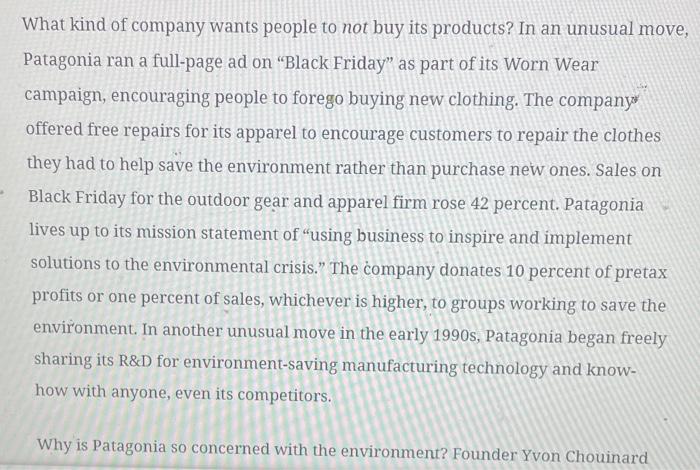
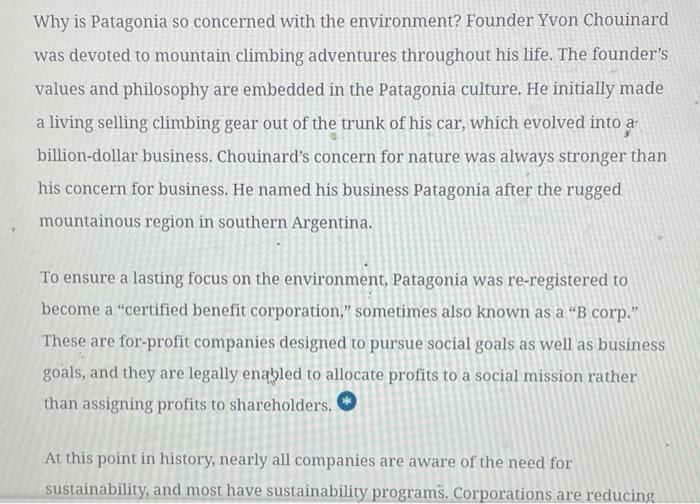
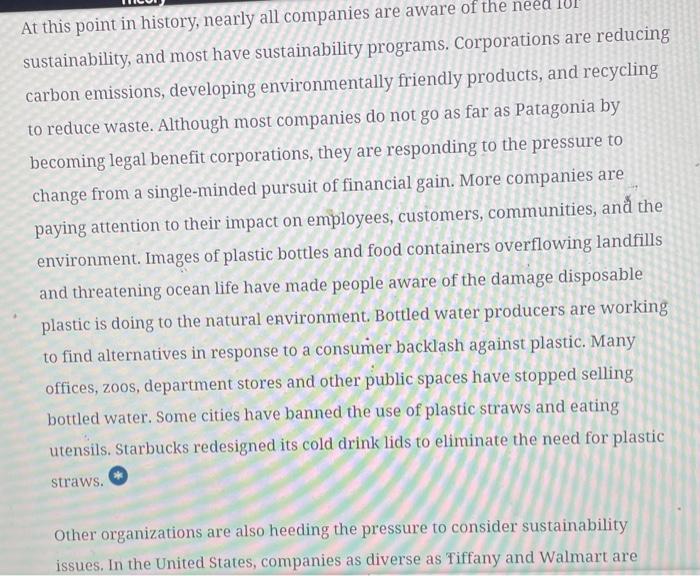
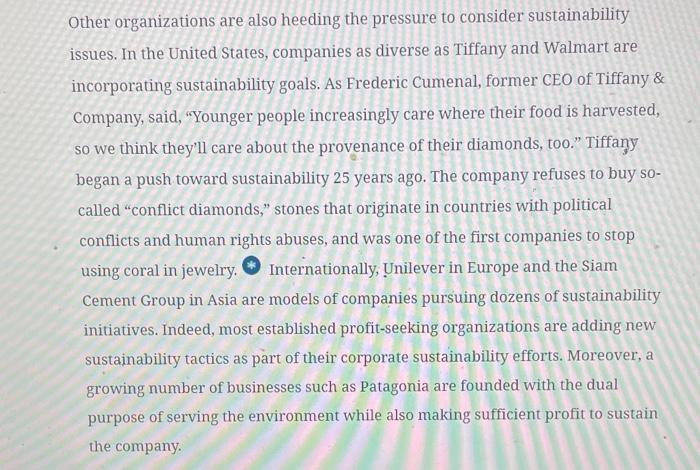
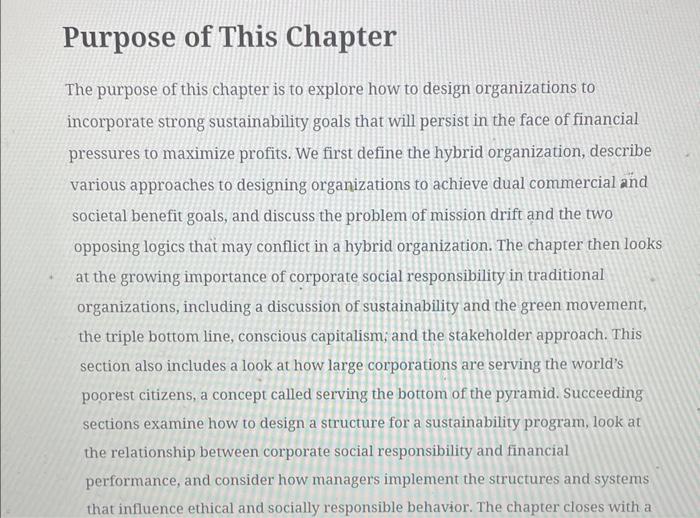
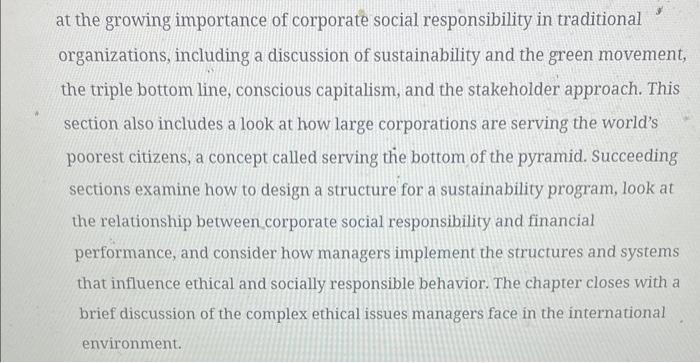
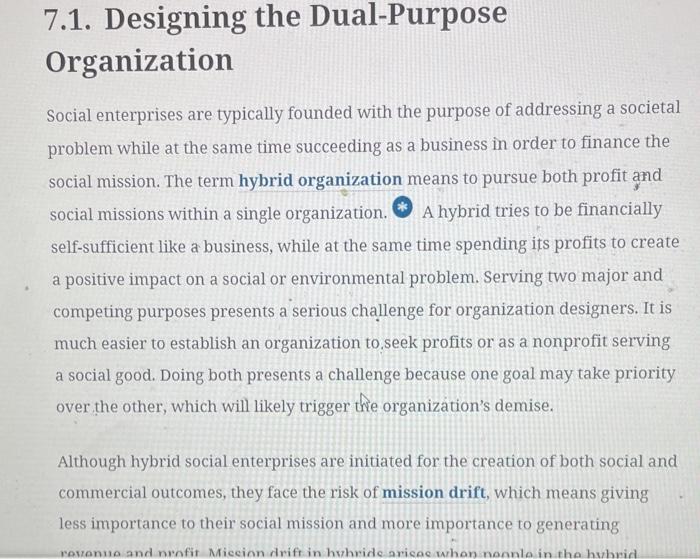
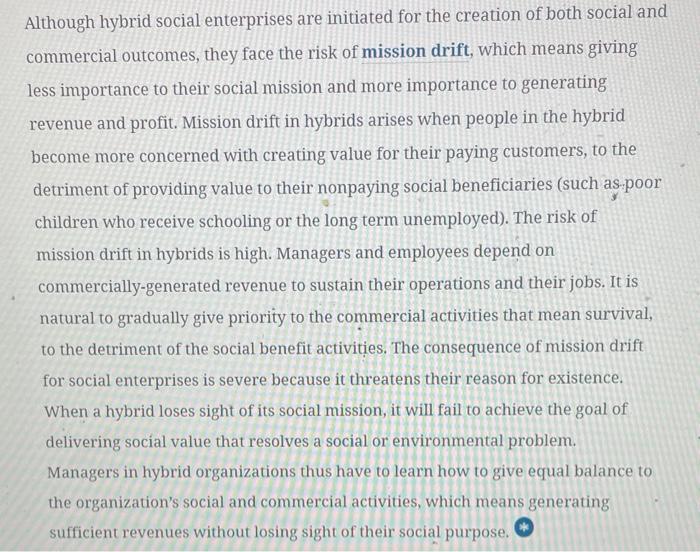
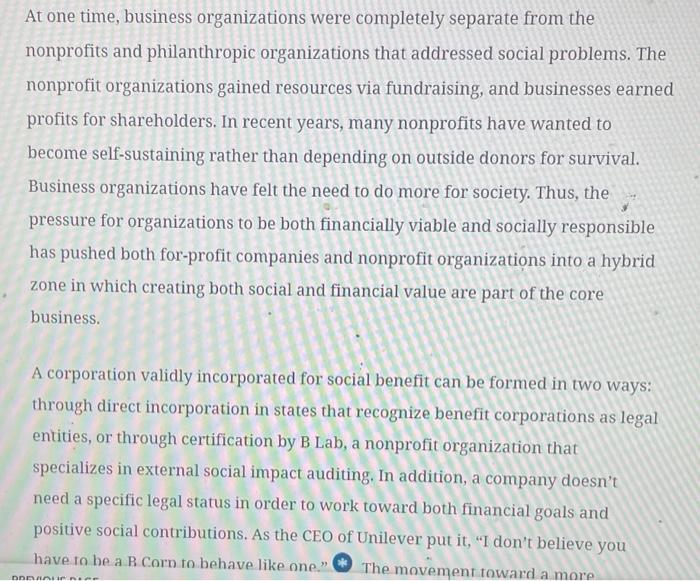


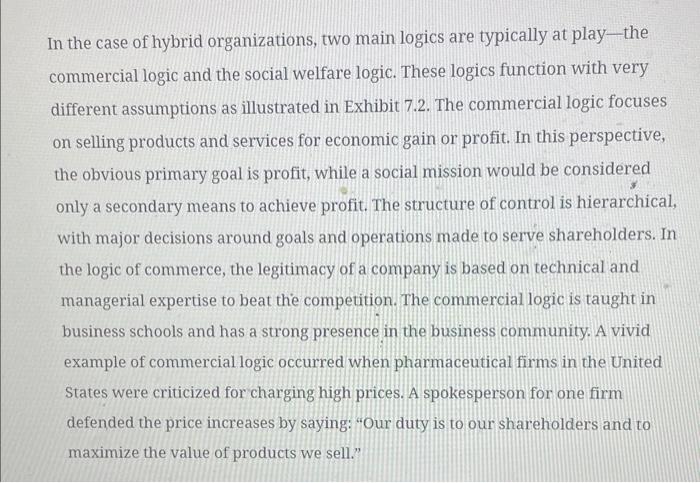
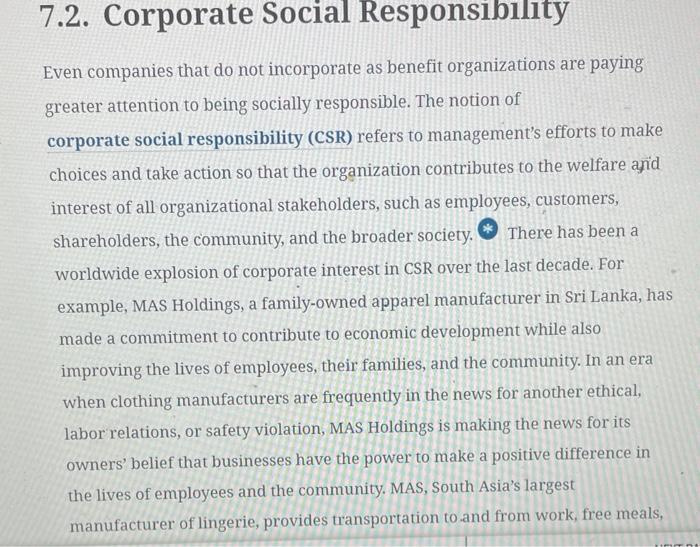
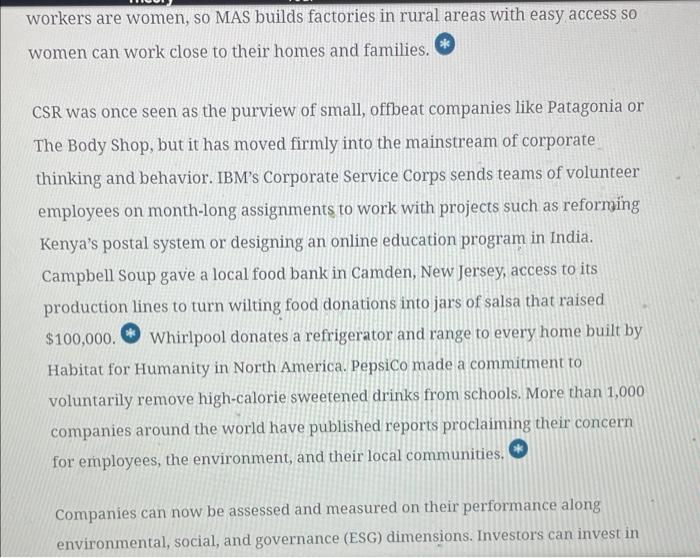
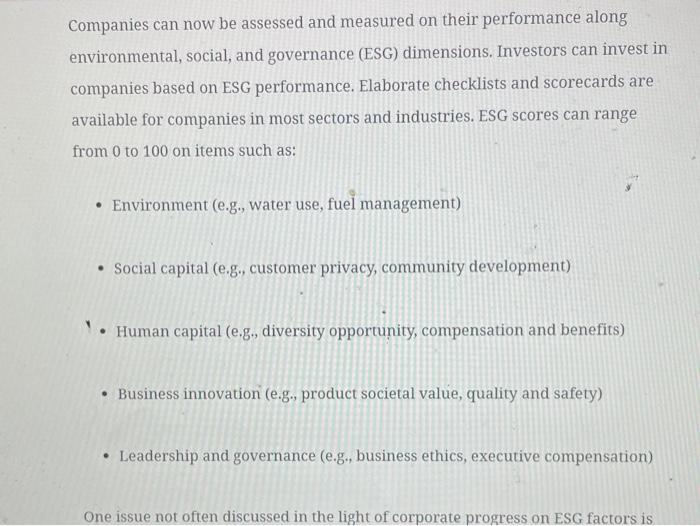
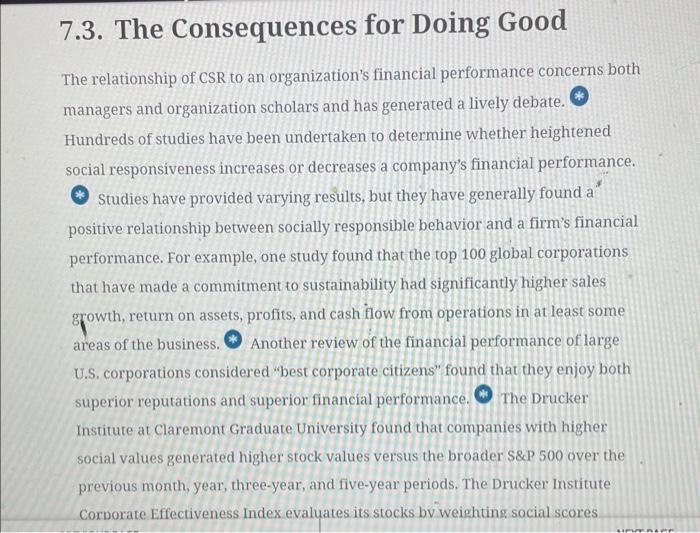
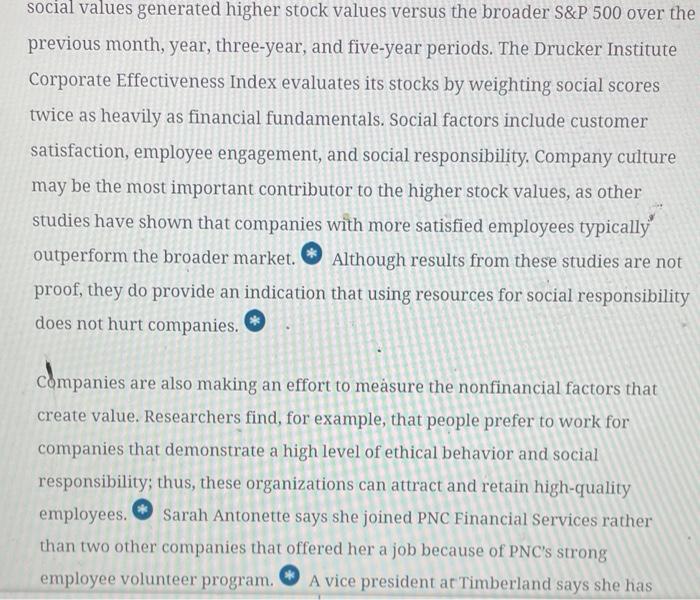

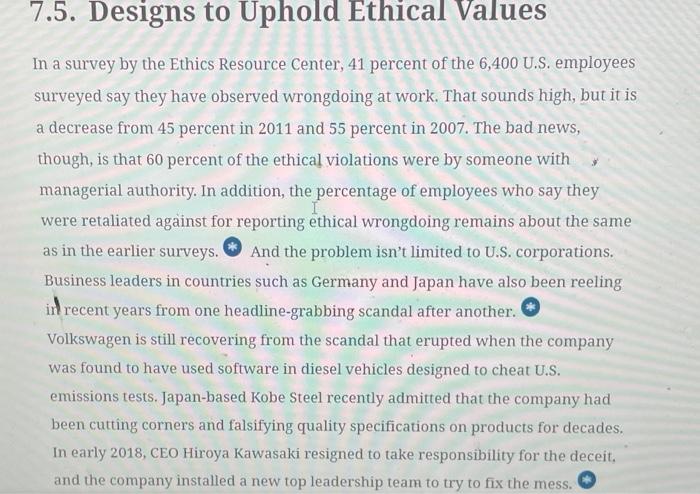
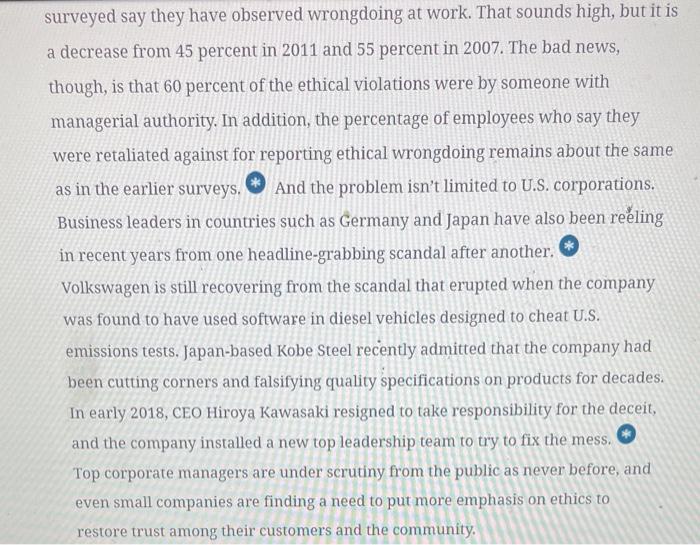
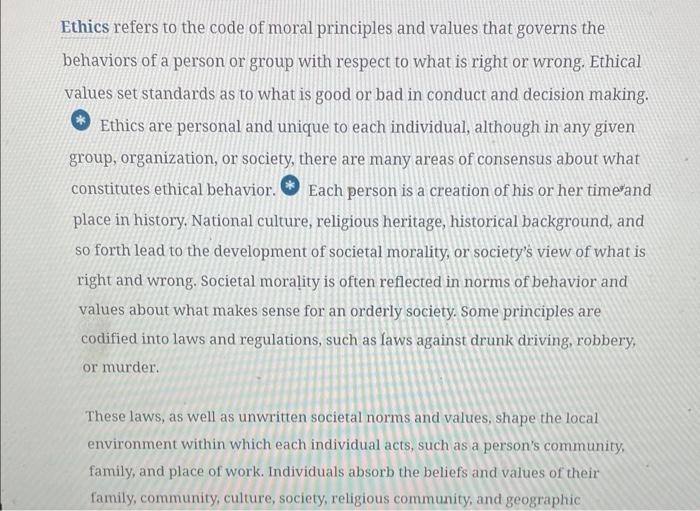

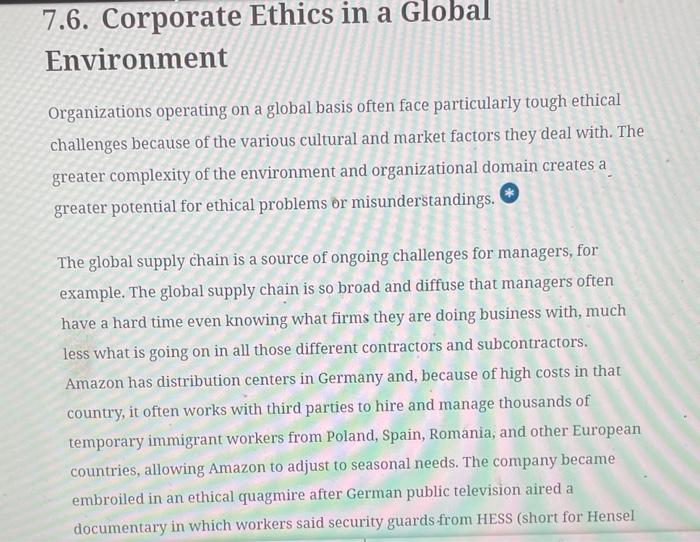

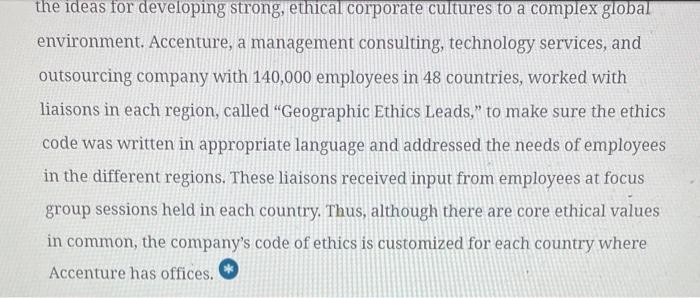
This is Chapter seven. 


























The Chapter is called :Designs for societal impact:Dual purpose organizations, Corporate Sustainability, and Ethics.
For this case study. Choose any chapter from either chapter six, seven, or eight to critique. Your case study must have the following. 1. Title Page 2. Subtitles such as: Introduction paragraph. Body of work Conclusion Recommendations. What kind of company wants people to not buy its products? In an unusual move, Patagonia ran a full-page ad on "Black Friday" as part of its Worn Wear campaign, encouraging people to forego buying new clothing. The company* offered free repairs for its apparel to encourage customers to repair the clothes they had to help save the environment rather than purchase new ones. Sales on Black Friday for the outdoor gear and apparel firm rose 42 percent. Patagonia lives up to its mission statement of "using business to inspire and implement solutions to the environmental crisis." The company donates 10 percent of pretax profits or one percent of sales, whichever is higher, to groups working to save the environment. In another unusual move in the early 1990s, Patagonia began freely sharing its R\&D for environment-saving manufacturing technology and knowhow with anyone, even its competitors. Why is Patagonia so concerned with the environment? Founder Yvon Chouinard was devoted to mountain climbing adventures throughout his life. The founder's values and philosophy are embedded in the Patagonia culture. He initially made a living selling climbing gear out of the trunk of his car, which evolved into ag billion-dollar business. Chouinard's concern for nature was always stronger than his concern for business. He named his business Patagonia after the rugged mountainous region in southern Argentina. To ensure a lasting focus on the environment, Patagonia was re-registered to become a "certified benefit corporation," sometimes also known as a "B corp." These are for-profit companies designed to pursue social goals as well as business goals, and they are legally enabled to allocate profits to a social mission rather than assigning profits to shareholders. At this point in history, nearly all companies are aware of the need for sustainability, and most have sustainability programs. Corporations are reducing At this point in history, nearly all companies are aware of the need tor sustainability, and most have sustainability programs. Corporations are reducing carbon emissions, developing environmentally friendly products, and recycling to reduce waste. Although most companies do not go as far as Patagonia by becoming legal benefit corporations, they are responding to the pressure to change from a single-minded pursuit of financial gain. More companies are paying attention to their impact on employees, customers, communities, and the environment. Images of plastic bottles and food containers overflowing landfills and threatening ocean life have made people aware of the damage disposable plastic is doing to the natural environment. Bottled water producers are working to find alternatives in response to a consumer backlash against plastic. Many offices, zoos, department stores and other public spaces have stopped selling bottled water. Some cities have banned the use of plastic straws and eating utensils. Starbucks redesigned its cold drink lids to eliminate the need for plastic straws. Other organizations are also heeding the pressure to consider sustainability issues. In the United States, companies as diverse as fiffany and Walmart are Other organizations are also heeding the pressure to consider sustainability issues. In the United States, companies as diverse as Tiffany and Walmart are incorporating sustainability goals. As Frederic Cumenal, former CEO of Tiffany \& Company, said, "Younger people increasingly care where their food is harvested, so we think they'll care about the provenance of their diamonds, too." Tiffanyy began a push toward sustainability 25 years ago. The company refuses to buy socalled "conflict diamonds," stones that originate in countries with political conflicts and human rights abuses, and was one of the first companies to stop using coral in jewelry. Internationally, Unilever in Europe and the Siam Cement Group in Asia are models of companies pursuing dozens of sustainability initiatives. Indeed, most established profit-seeking organizations are adding new sustainability tactics as part of their corporate sustainability efforts. Moreover, a growing number of businesses such as Patagonia are founded with the dual purpose of serving the environment while also making sufficient profit to sustain the company. The purpose of this chapter is to explore how to design organizations to incorporate strong sustainability goals that will persist in the face of financial pressures to maximize profits. We first define the hybrid organization, describe various approaches to designing organizations to achieve dual commercial and societal benefit goals, and discuss the problem of mission drift and the two opposing logics that may conflict in a hybrid organization. The chapter then looks at the growing importance of corporate social responsibility in traditional organizations, including a discussion of sustainability and the green movement, the triple bottom line, conscious capitalism; and the stakeholder approach. This section also includes a look at how large corporations are serving the world's poorest citizens, a concept called serving the bottom of the pyramid. Succeeding sections examine how to design a structure for a sustainability program, 10ok at the relationship between corporate social responsibility and financial performance, and consider how managers implement the structures and systems that influence ethical and socially responsible behavior. The chapter closes with a at the growing importance of corporate social responsibility in traditional organizations, including a discussion of sustainability and the green movement, the triple bottom line, conscious capitalism, and the stakeholder approach. This section also includes a look at how large corporations are serving the world's poorest citizens, a concept called serving the bottom of the pyramid. Succeeding sections examine how to design a structure for a sustainability program, look at the relationship between corporate social responsibility and financial performance, and consider how managers implement the structures and systems that influence ethical and socially responsible behavior. The chapter closes with a brief discussion of the complex ethical issues managers face in the international environment. Social enterprises are typically founded with the purpose of addressing a societal problem while at the same time succeeding as a business in order to finance the social mission. The term hybrid organization means to pursue both profit and social missions within a single organization. A hybrid tries to be financially self-sufficient like a business, while at the same time spending its profits to create a positive impact on a social or environmental problem. Serving two major and competing purposes presents a serious challenge for organization designers. It is much easier to establish an organization to seek profits or as a nonprofit serving a social good. Doing both presents a challenge because one goal may take priority over the other, which will likely trigger the organization's demise. Although hybrid social enterprises are initiated for the creation of both social and commercial outcomes, they face the risk of mission drift, which means giving less importance to their social mission and more importance to generating Although hybrid social enterprises are initiated for the creation of both social and commercial outcomes, they face the risk of mission drift, which means giving less importance to their social mission and more importance to generating revenue and profit. Mission drift in hybrids arises when people in the hybrid become more concerned with creating value for their paying customers, to the detriment of providing value to their nonpaying social beneficiaries (such as poor children who receive schooling or the long term unemployed). The risk of mission drift in hybrids is high. Managers and employees depend on commercially-generated revenue to sustain their operations and their jobs. It is natural to gradually give priority to the commercial activities that mean survival, to the detriment of the social benefit activities. The consequence of mission drift for social enterprises is severe because it threatens their reason for existence. When a hybrid loses sight of its social mission, it will fail to achieve the goal of delivering social value that resolves a social or environmental problem. Managers in hybrid organizations thus have to learn how to give equal balance to the organization's social and commercial activities, which means generating sufficient revenues without losing sight of their social purpose. At one time, business organizations were completely separate from the nonprofits and philanthropic organizations that addressed social problems. The nonprofit organizations gained resources via fundraising, and businesses earned profits for shareholders. In recent years, many nonprofits have wanted to become self-sustaining rather than depending on outside donors for survival. Business organizations have felt the need to do more for society. Thus, the pressure for organizations to be both financially viable and socially responsible has pushed both for-profit companies and nonprofit organizations into a hybrid zone in which creating both social and financial value are part of the core business. A corporation validly incorporated for social benefit can be formed in two ways: through direct incorporation in states that recognize benefit corporations as legal entities, or through certification by B Lab, a nonprofit organization that specializes in external social impact auditing. In addition, a company doesn't need a specific legal status in order to work toward both financial goals and positive social contributions. As the CEO of Unilever put it, "I don't believe you have in be a B Corn to behave like nne." have to be a B Corp to behave like one." The movement toward a more hybrid-like approach has taken different names, such as dual-purpose, shared value, conscious capitalism, social entrepreneurship, benefit corporations, and B corporation certification, as defined in Exhibit 7.1. Although specific aspects of each type do vary, each organization form and philosophy is intended to create something of financial value that also has positive social impact. The AND1 example shows how fragile a social mission can be in a profit-seeking business. The profit mission obliterated the social mission. Why do these two missions so often produce internal company strife and conflict? Below the surface of the company's twin missions are employees' personal beliefs, values, and preferences, which are call logics. A logic means a person's basic assumptions, values, and beliefs that he or she thinks should guide an organization's behavior. These values and beliefs give meaning to people's daily lives. Moreover, people usually-believe their logic is correct and should take precedence over other logics. The notion of a deeper logic explains why deeply embedded conflicts arise in a hybrid organization. Peoples' logics reflect beliefs and values that they want to see in their work practices and organizational purposes. These logics often put some people on one side and some on the other side of the divide between social versus profit outcomes, creating conflict within a hybrid organization. Logics are not about job satisfaction; they are deeper and typically are brought to work as part of one's life values. In the case of hybrid organizations, two main logics are typically at play-the commercial logic and the social welfare logic. These logics function with very different assumptions as illustrated in Exhibit 7.2. The commercial logic focuses on selling products and services for economic gain or profit. In this perspective, the obvious primary goal is profit, while a social mission would be considered only a secondary means to achieve profit. The structure of control is hierarchical, with major decisions around goals and operations made to serve shareholders. In the logic of commerce, the legitimacy of a company is based on technical and managerial expertise to beat the competition. The commercial logic is taught in business schools and has a strong presence in the business community. A vivid example of commercial logic occurred when pharmaceutical firms in the United States were criticized for charging high prices. A spokesperson for one firm defended the price increases by saying: "Our duty is to our shareholders and to maximize the value of products we sell." Even companies that do not incorporate as benefit organizations are paying greater attention to being socially responsible. The notion of corporate social responsibility (CSR) refers to management's efforts to make choices and take action so that the organization contributes to the welfare and interest of all organizational stakeholders, such as employees, customers, shareholders, the community, and the broader society. There has been a worldwide explosion of corporate interest in CSR over the last decade. For example, MAS Holdings, a family-owned apparel manufacturer in Sri Lanka, has made a commitment to contribute to economic development while also improving the lives of employees, their families, and the community. In an era when clothing manufacturers are frequently in the news for another ethical, labor relations, or safety violation, MAS Holdings is making the news for its owners' belief that businesses have the power to make a positive difference in the lives of employees and the community. MAS, South Asia's largest manufacturer of lingerie, provides transportation to and from work, free meals, women can work close to their homes and families. CSR was once seen as the purview of small, offbeat companies like Patagonia or The Body Shop, but it has moved firmly into the mainstream of corporate thinking and behavior. IBM's Corporate Service Corps sends teams of volunteer employees on month-long assignments to work with projects such as reforming Kenya's postal system or designing an online education program in India. Campbell Soup gave a local food bank in Camden, New Jersey, access to its production lines to turn wilting food donations into jars of salsa that raised $100,000. * Whirlpool donates a refrigerator and range to every home built by Habitat for Humanity in North America. Pepsico made a commitment to voluntarily remove high-calorie sweetened drinks from schools. More than 1,000 companies around the world have published reports proclaiming their concern for employees, the environment, and their local communities. Companies can now be assessed and measured on their performance along environmental, social, and governance (ESG) dimensions. Investors can invest in Companies can now be assessed and measured on their performance along environmental, social, and governance (ESG) dimensions. Investors can invest in companies based on ESG performance. Elaborate checklists and scorecards are available for companies in most sectors and industries. ESG scores can range from 0 to 100 on items such as: - Environment (e.g., water use, fuel management) - Social capital (e.g., customer privacy, community development) - Human capital (e.g., diversity opportunity, compensation and benefits) - Business innovation (e.g., product societal value, quality and safety) - Leadership and governance (e.g., business ethics, executive compensation) One issue not often discussed in the light of corporate progress on ESG factors is The relationship of CSR to an organization's financial performance concerns both managers and organization scholars and has generated a lively debate. Hundreds of studies have been undertaken to determine whether heightened social responsiveness increases or decreases a company's financial performance. Studies have provided varying results, but they have generally found a" positive relationship between socially responsible behavior and a firm's financial performance. For example, one study found that the top 100 global corporations that have made a commitment to sustainability had significantly higher sales gowth, return on assets, profits, and cash flow from operations in at least some areas of the business. * Another review of the financial performance of large U.S. corporations considered "best corporate citizens" found that they enjoy both superior reputations and superior financial performance. ( The Drucker Institute at Claremont Graduate University found that companies with higher social values generated higher stock values versus the broader S\&P 500 over the previous month, year, three-year, and five-year periods. The Drucker Institute Corborate Effectiveness Index evaluates its stocks bv weighting social scores social values generated higher stock values versus the broader S\&P 500 over the previous month, year, three-year, and five-year periods. The Drucker Institute Corporate Effectiveness Index evaluates its stocks by weighting social scores twice as heavily as financial fundamentals. Social factors include customer satisfaction, employee engagement, and social responsibility. Company culture may be the most important contributor to the higher stock values, as other studies have shown that companies with more satisfied employees typically outperform the broader market. Although results from these studies are not proof, they do provide an indication that using resources for social responsibility does not hurt companies. companies are also making an effort to measure the nonfinancial factors that create value. Researchers find, for example, that people prefer to work for companies that demonstrate a high level of ethical behavior and social responsibility; thus, these organizations can attract and retain high-quality employees. Sarah Antonette says she joined PNC Financial Services rather than two other companies that offered her a job because of PNC's strong employee volunteer program. A vice president at Timberland says she has 7.4. Designing a Structure for Executing a Sustainability Program Successfully implementing a sustainability or CSR program depends heavily on three things: engaging employees, engaging outside stakeholders, and engaging a system of accountability that includes metrics and rewards. In a survey by the Ethics Resource Center, 41 percent of the 6,400 U.S. employees surveyed say they have observed wrongdoing at work. That sounds high, but it is a decrease from 45 percent in 2011 and 55 percent in 2007. The bad news, though, is that 60 percent of the ethical violations were by someone with managerial authority. In addition, the percentage of employees who say they were retaliated against for reporting ethical wrongdoing remains about the same as in the earlier surveys. And the problem isn't limited to U.S. corporations. Business leaders in countries such as Germany and Japan have also been reeling in recent years from one headline-grabbing scandal after another. Volkswagen is still recovering from the scandal that erupted when the company was found to have used software in diesel vehicles designed to cheat U.S. emissions tests. Japan-based Kobe Steel recently admitted that the company had been cutting corners and falsifying quality specifications on products for decades. In early 2018, CEO Hiroya Kawasaki resigned to take responsibility for the deceit, and the company installed a new top leadership team to try to fix the mess. surveyed say they have observed wrongdoing at work. That sounds high, but it is a decrease from 45 percent in 2011 and 55 percent in 2007. The bad news, though, is that 60 percent of the ethical violations were by someone with managerial authority. In addition, the percentage of employees who say they were retaliated against for reporting ethical wrongdoing remains about the same as in the earlier surveys. * And the problem isn't limited to U.S. corporations. Business leaders in countries such as Germany and Japan have also been reeling in recent years from one headline-grabbing scandal after another. Volkswagen is still recovering from the scandal that erupted when the company was found to have used software in diesel vehicles designed to cheat U.S. emissions tests. Japan-based Kobe steel recently admitted that the company had been cutting corners and falsifying quality specifications on products for decades. In early 2018, CEO Hiroya Kawasaki resigned to take responsibility for the deceit, and the company installed a new top leadership team to try to fix the mess. Top corporate managers are under scrutiny from the public as never before, and even small companies are finding a need to put more emphasis on ethics to restore trust among their customers and the community. Ethics refers to the code of moral principles and values that governs the behaviors of a person or group with respect to what is right or wrong. Ethical values set standards as to what is good or bad in conduct and decision making. Ethics are personal and unique to each individual, although in any given group, organization, or society, there are many areas of consensus about what constitutes ethical behavior. * Each person is a creation of his or her time*and place in history. National culture, religious heritage, historical background, and so forth lead to the development of societal morality, or society's view of what is right and wrong. Societal morality is often reflected in norms of behavior and values about what makes sense for an orderly society. Some principles are codified into laws and regulations, such as laws against drunk driving, robbery, or murder. These laws, as well as unwritten societal norms and values, shape the local environment within which each individual acts, such as a person's community, family, and place of work. Individuals absorb the beliefs and values of their family, community, culture, society, religious community, and geographic These laws, as well as unwritten societal norms and values, shape the local environment within which each individual acts, such as a person's community, family, and place of work. Individuals absorb the beliefs and values of their family, community, culture, society, religious community, and geographic environment, typically discarding some and incorporating others into their own personal ethical standards. Each person's ethical stance is thus a blending of his or her historical, cultural, societal, and family backgrounds and influences. It is important to look at individual ethics because ethical behavior always involves an individual action, whether it is a decision to act or the failure to take action against wrongdoing by others. In organizations, an individual's ethical stance may be affected by peers, subordinates, and supervisors, as well as by the organizational culture, Organizational culture often has a profound influence on individual choices and can support and encourage ethical actions or promote unethical and socially irresponsible behavior. Environment Organizations operating on a global basis often face particularly tough ethical challenges because of the various cultural and market factors they deal with. The greater complexity of the environment and organizational domain creates a greater potential for ethical problems or misunderstandings. The global supply chain is a source of ongoing challenges for managers, for example. The global supply chain is so broad and diffuse that managers often have a hard time even knowing what firms they are doing business with, much less what is going on in all those different contractors and subcontractors. Amazon has distribution centers in Germany and, because of high costs in that country, it often works with third parties to hire and manage thousands of temporary immigrant workers from Poland, Spain, Romania, and other European countries, allowing Amazon to adjust to seasonal needs. The company became embroiled in an ethical quagmire after German public television aired a documentary in which workers said security guards from HESS (short for Hensel countries, allowing Amazon to adjust to seasonal needs. The company became embroiled in an ethical quagmire after German public television aired a documentary in which workers said security guards from HESS (short for Hensel European Security Services) intimidate them, search them for pilfered food, and spot-check their cramped living quarters unannounced. The program showed some guards wearing clothing from Thor Steinar, a German fashion label popular with the country's neo-Nazi community. Amazon immediately stopped doing business with HESS, whose executives denied the allegations and said, "We explicitly distance ourselves from any form of political radicalism." Another concern when doing business globally is that employees from different countries may have varied attitudes and beliefs that make it difficult to establish a sense of community and cohesiveness based on the ethical culture. In fact, research has indicated that national culture has a greater impact on employees than does corporate culture, and differences in national culture also create tremendous variance in ethical attitudes. Managers often struggle to translate the ideas for developing strong, ethical corporate cultures to a complex global environment. Accenture, a management consulting, technology services, and environment. Accenture, a management consulting, technology services, and outsourcing company with 140,000 employees in 48 countries, worked with liaisons in each region, called "Geographic Ethics Leads," to make sure the ethics code was written in appropriate language and addressed the needs of employees in the different regions. These liaisons received input from employees at focus group sessions held in each country. Thus, although there are core ethical values in common, the company's code of ethics is customized for each country where Accenture has offices. For this case study. Choose any chapter from either chapter six, seven, or eight to critique. Your case study must have the following. 1. Title Page 2. Subtitles such as: Introduction paragraph. Body of work Conclusion Recommendations. What kind of company wants people to not buy its products? In an unusual move, Patagonia ran a full-page ad on "Black Friday" as part of its Worn Wear campaign, encouraging people to forego buying new clothing. The company* offered free repairs for its apparel to encourage customers to repair the clothes they had to help save the environment rather than purchase new ones. Sales on Black Friday for the outdoor gear and apparel firm rose 42 percent. Patagonia lives up to its mission statement of "using business to inspire and implement solutions to the environmental crisis." The company donates 10 percent of pretax profits or one percent of sales, whichever is higher, to groups working to save the environment. In another unusual move in the early 1990s, Patagonia began freely sharing its R\&D for environment-saving manufacturing technology and knowhow with anyone, even its competitors. Why is Patagonia so concerned with the environment? Founder Yvon Chouinard was devoted to mountain climbing adventures throughout his life. The founder's values and philosophy are embedded in the Patagonia culture. He initially made a living selling climbing gear out of the trunk of his car, which evolved into ag billion-dollar business. Chouinard's concern for nature was always stronger than his concern for business. He named his business Patagonia after the rugged mountainous region in southern Argentina. To ensure a lasting focus on the environment, Patagonia was re-registered to become a "certified benefit corporation," sometimes also known as a "B corp." These are for-profit companies designed to pursue social goals as well as business goals, and they are legally enabled to allocate profits to a social mission rather than assigning profits to shareholders. At this point in history, nearly all companies are aware of the need for sustainability, and most have sustainability programs. Corporations are reducing At this point in history, nearly all companies are aware of the need tor sustainability, and most have sustainability programs. Corporations are reducing carbon emissions, developing environmentally friendly products, and recycling to reduce waste. Although most companies do not go as far as Patagonia by becoming legal benefit corporations, they are responding to the pressure to change from a single-minded pursuit of financial gain. More companies are paying attention to their impact on employees, customers, communities, and the environment. Images of plastic bottles and food containers overflowing landfills and threatening ocean life have made people aware of the damage disposable plastic is doing to the natural environment. Bottled water producers are working to find alternatives in response to a consumer backlash against plastic. Many offices, zoos, department stores and other public spaces have stopped selling bottled water. Some cities have banned the use of plastic straws and eating utensils. Starbucks redesigned its cold drink lids to eliminate the need for plastic straws. Other organizations are also heeding the pressure to consider sustainability issues. In the United States, companies as diverse as fiffany and Walmart are Other organizations are also heeding the pressure to consider sustainability issues. In the United States, companies as diverse as Tiffany and Walmart are incorporating sustainability goals. As Frederic Cumenal, former CEO of Tiffany \& Company, said, "Younger people increasingly care where their food is harvested, so we think they'll care about the provenance of their diamonds, too." Tiffanyy began a push toward sustainability 25 years ago. The company refuses to buy socalled "conflict diamonds," stones that originate in countries with political conflicts and human rights abuses, and was one of the first companies to stop using coral in jewelry. Internationally, Unilever in Europe and the Siam Cement Group in Asia are models of companies pursuing dozens of sustainability initiatives. Indeed, most established profit-seeking organizations are adding new sustainability tactics as part of their corporate sustainability efforts. Moreover, a growing number of businesses such as Patagonia are founded with the dual purpose of serving the environment while also making sufficient profit to sustain the company. The purpose of this chapter is to explore how to design organizations to incorporate strong sustainability goals that will persist in the face of financial pressures to maximize profits. We first define the hybrid organization, describe various approaches to designing organizations to achieve dual commercial and societal benefit goals, and discuss the problem of mission drift and the two opposing logics that may conflict in a hybrid organization. The chapter then looks at the growing importance of corporate social responsibility in traditional organizations, including a discussion of sustainability and the green movement, the triple bottom line, conscious capitalism; and the stakeholder approach. This section also includes a look at how large corporations are serving the world's poorest citizens, a concept called serving the bottom of the pyramid. Succeeding sections examine how to design a structure for a sustainability program, 10ok at the relationship between corporate social responsibility and financial performance, and consider how managers implement the structures and systems that influence ethical and socially responsible behavior. The chapter closes with a at the growing importance of corporate social responsibility in traditional organizations, including a discussion of sustainability and the green movement, the triple bottom line, conscious capitalism, and the stakeholder approach. This section also includes a look at how large corporations are serving the world's poorest citizens, a concept called serving the bottom of the pyramid. Succeeding sections examine how to design a structure for a sustainability program, look at the relationship between corporate social responsibility and financial performance, and consider how managers implement the structures and systems that influence ethical and socially responsible behavior. The chapter closes with a brief discussion of the complex ethical issues managers face in the international environment. Social enterprises are typically founded with the purpose of addressing a societal problem while at the same time succeeding as a business in order to finance the social mission. The term hybrid organization means to pursue both profit and social missions within a single organization. A hybrid tries to be financially self-sufficient like a business, while at the same time spending its profits to create a positive impact on a social or environmental problem. Serving two major and competing purposes presents a serious challenge for organization designers. It is much easier to establish an organization to seek profits or as a nonprofit serving a social good. Doing both presents a challenge because one goal may take priority over the other, which will likely trigger the organization's demise. Although hybrid social enterprises are initiated for the creation of both social and commercial outcomes, they face the risk of mission drift, which means giving less importance to their social mission and more importance to generating Although hybrid social enterprises are initiated for the creation of both social and commercial outcomes, they face the risk of mission drift, which means giving less importance to their social mission and more importance to generating revenue and profit. Mission drift in hybrids arises when people in the hybrid become more concerned with creating value for their paying customers, to the detriment of providing value to their nonpaying social beneficiaries (such as poor children who receive schooling or the long term unemployed). The risk of mission drift in hybrids is high. Managers and employees depend on commercially-generated revenue to sustain their operations and their jobs. It is natural to gradually give priority to the commercial activities that mean survival, to the detriment of the social benefit activities. The consequence of mission drift for social enterprises is severe because it threatens their reason for existence. When a hybrid loses sight of its social mission, it will fail to achieve the goal of delivering social value that resolves a social or environmental problem. Managers in hybrid organizations thus have to learn how to give equal balance to the organization's social and commercial activities, which means generating sufficient revenues without losing sight of their social purpose. At one time, business organizations were completely separate from the nonprofits and philanthropic organizations that addressed social problems. The nonprofit organizations gained resources via fundraising, and businesses earned profits for shareholders. In recent years, many nonprofits have wanted to become self-sustaining rather than depending on outside donors for survival. Business organizations have felt the need to do more for society. Thus, the pressure for organizations to be both financially viable and socially responsible has pushed both for-profit companies and nonprofit organizations into a hybrid zone in which creating both social and financial value are part of the core business. A corporation validly incorporated for social benefit can be formed in two ways: through direct incorporation in states that recognize benefit corporations as legal entities, or through certification by B Lab, a nonprofit organization that specializes in external social impact auditing. In addition, a company doesn't need a specific legal status in order to work toward both financial goals and positive social contributions. As the CEO of Unilever put it, "I don't believe you have in be a B Corn to behave like nne." have to be a B Corp to behave like one." The movement toward a more hybrid-like approach has taken different names, such as dual-purpose, shared value, conscious capitalism, social entrepreneurship, benefit corporations, and B corporation certification, as defined in Exhibit 7.1. Although specific aspects of each type do vary, each organization form and philosophy is intended to create something of financial value that also has positive social impact. The AND1 example shows how fragile a social mission can be in a profit-seeking business. The profit mission obliterated the social mission. Why do these two missions so often produce internal company strife and conflict? Below the surface of the company's twin missions are employees' personal beliefs, values, and preferences, which are call logics. A logic means a person's basic assumptions, values, and beliefs that he or she thinks should guide an organization's behavior. These values and beliefs give meaning to people's daily lives. Moreover, people usually-believe their logic is correct and should take precedence over other logics. The notion of a deeper logic explains why deeply embedded conflicts arise in a hybrid organization. Peoples' logics reflect beliefs and values that they want to see in their work practices and organizational purposes. These logics often put some people on one side and some on the other side of the divide between social versus profit outcomes, creating conflict within a hybrid organization. Logics are not about job satisfaction; they are deeper and typically are brought to work as part of one's life values. In the case of hybrid organizations, two main logics are typically at play-the commercial logic and the social welfare logic. These logics function with very different assumptions as illustrated in Exhibit 7.2. The commercial logic focuses on selling products and services for economic gain or profit. In this perspective, the obvious primary goal is profit, while a social mission would be considered only a secondary means to achieve profit. The structure of control is hierarchical, with major decisions around goals and operations made to serve shareholders. In the logic of commerce, the legitimacy of a company is based on technical and managerial expertise to beat the competition. The commercial logic is taught in business schools and has a strong presence in the business community. A vivid example of commercial logic occurred when pharmaceutical firms in the United States were criticized for charging high prices. A spokesperson for one firm defended the price increases by saying: "Our duty is to our shareholders and to maximize the value of products we sell." Even companies that do not incorporate as benefit organizations are paying greater attention to being socially responsible. The notion of corporate social responsibility (CSR) refers to management's efforts to make choices and take action so that the organization contributes to the welfare and interest of all organizational stakeholders, such as employees, customers, shareholders, the community, and the broader society. There has been a worldwide explosion of corporate interest in CSR over the last decade. For example, MAS Holdings, a family-owned apparel manufacturer in Sri Lanka, has made a commitment to contribute to economic development while also improving the lives of employees, their families, and the community. In an era when clothing manufacturers are frequently in the news for another ethical, labor relations, or safety violation, MAS Holdings is making the news for its owners' belief that businesses have the power to make a positive difference in the lives of employees and the community. MAS, South Asia's largest manufacturer of lingerie, provides transportation to and from work, free meals, women can work close to their homes and families. CSR was once seen as the purview of small, offbeat companies like Patagonia or The Body Shop, but it has moved firmly into the mainstream of corporate thinking and behavior. IBM's Corporate Service Corps sends teams of volunteer employees on month-long assignments to work with projects such as reforming Kenya's postal system or designing an online education program in India. Campbell Soup gave a local food bank in Camden, New Jersey, access to its production lines to turn wilting food donations into jars of salsa that raised $100,000. * Whirlpool donates a refrigerator and range to every home built by Habitat for Humanity in North America. Pepsico made a commitment to voluntarily remove high-calorie sweetened drinks from schools. More than 1,000 companies around the world have published reports proclaiming their concern for employees, the environment, and their local communities. Companies can now be assessed and measured on their performance along environmental, social, and governance (ESG) dimensions. Investors can invest in Companies can now be assessed and measured on their performance along environmental, social, and governance (ESG) dimensions. Investors can invest in companies based on ESG performance. Elaborate checklists and scorecards are available for companies in most sectors and industries. ESG scores can range from 0 to 100 on items such as: - Environment (e.g., water use, fuel management) - Social capital (e.g., customer privacy, community development) - Human capital (e.g., diversity opportunity, compensation and benefits) - Business innovation (e.g., product societal value, quality and safety) - Leadership and governance (e.g., business ethics, executive compensation) One issue not often discussed in the light of corporate progress on ESG factors is The relationship of CSR to an organization's financial performance concerns both managers and organization scholars and has generated a lively debate. Hundreds of studies have been undertaken to determine whether heightened social responsiveness increases or decreases a company's financial performance. Studies have provided varying results, but they have generally found a" positive relationship between socially responsible behavior and a firm's financial performance. For example, one study found that the top 100 global corporations that have made a commitment to sustainability had significantly higher sales gowth, return on assets, profits, and cash flow from operations in at least some areas of the business. * Another review of the financial performance of large U.S. corporations considered "best corporate citizens" found that they enjoy both superior reputations and superior financial performance. ( The Drucker Institute at Claremont Graduate University found that companies with higher social values generated higher stock values versus the broader S\&P 500 over the previous month, year, three-year, and five-year periods. The Drucker Institute Corborate Effectiveness Index evaluates its stocks bv weighting social scores social values generated higher stock values versus the broader S\&P 500 over the previous month, year, three-year, and five-year periods. The Drucker Institute Corporate Effectiveness Index evaluates its stocks by weighting social scores twice as heavily as financial fundamentals. Social factors include customer satisfaction, employee engagement, and social responsibility. Company culture may be the most important contributor to the higher stock values, as other studies have shown that companies with more satisfied employees typically outperform the broader market. Although results from these studies are not proof, they do provide an indication that using resources for social responsibility does not hurt companies. companies are also making an effort to measure the nonfinancial factors that create value. Researchers find, for example, that people prefer to work for companies that demonstrate a high level of ethical behavior and social responsibility; thus, these organizations can attract and retain high-quality employees. Sarah Antonette says she joined PNC Financial Services rather than two other companies that offered her a job because of PNC's strong employee volunteer program. A vice president at Timberland says she has 7.4. Designing a Structure for Executing a Sustainability Program Successfully implementing a sustainability or CSR program depends heavily on three things: engaging employees, engaging outside stakeholders, and engaging a system of accountability that includes metrics and rewards. In a survey by the Ethics Resource Center, 41 percent of the 6,400 U.S. employees surveyed say they have observed wrongdoing at work. That sounds high, but it is a decrease from 45 percent in 2011 and 55 percent in 2007. The bad news, though, is that 60 percent of the ethical violations were by someone with managerial authority. In addition, the percentage of employees who say they were retaliated against for reporting ethical wrongdoing remains about the same as in the earlier surveys. And the problem isn't limited to U.S. corporations. Business leaders in countries such as Germany and Japan have also been reeling in recent years from one headline-grabbing scandal after another. Volkswagen is still recovering from the scandal that erupted when the company was found to have used software in diesel vehicles designed to cheat U.S. emissions tests. Japan-based Kobe Steel recently admitted that the company had been cutting corners and falsifying quality specifications on products for decades. In early 2018, CEO Hiroya Kawasaki resigned to take responsibility for the deceit, and the company installed a new top leadership team to try to fix the mess. surveyed say they have observed wrongdoing at work. That sounds high, but it is a decrease from 45 percent in 2011 and 55 percent in 2007. The bad news, though, is that 60 percent of the ethical violations were by someone with managerial authority. In addition, the percentage of employees who say they were retaliated against for reporting ethical wrongdoing remains about the same as in the earlier surveys. * And the problem isn't limited to U.S. corporations. Business leaders in countries such as Germany and Japan have also been reeling in recent years from one headline-grabbing scandal after another. Volkswagen is still recovering from the scandal that erupted when the company was found to have used software in diesel vehicles designed to cheat U.S. emissions tests. Japan-based Kobe steel recently admitted that the company had been cutting corners and falsifying quality specifications on products for decades. In early 2018, CEO Hiroya Kawasaki resigned to take responsibility for the deceit, and the company installed a new top leadership team to try to fix the mess. Top corporate managers are under scrutiny from the public as never before, and even small companies are finding a need to put more emphasis on ethics to restore trust among their customers and the community. Ethics refers to the code of moral principles and values that governs the behaviors of a person or group with respect to what is right or wrong. Ethical values set standards as to what is good or bad in conduct and decision making. Ethics are personal and unique to each individual, although in any given group, organization, or society, there are many areas of consensus about what constitutes ethical behavior. * Each person is a creation of his or her time*and place in history. National culture, religious heritage, historical background, and so forth lead to the development of societal morality, or society's view of what is right and wrong. Societal morality is often reflected in norms of behavior and values about what makes sense for an orderly society. Some principles are codified into laws and regulations, such as laws against drunk driving, robbery, or murder. These laws, as well as unwritten societal norms and values, shape the local environment within which each individual acts, such as a person's community, family, and place of work. Individuals absorb the beliefs and values of their family, community, culture, society, religious community, and geographic These laws, as well as unwritten societal norms and values, shape the local environment within which each individual acts, such as a person's community, family, and place of work. Individuals absorb the beliefs and values of their family, community, culture, society, religious community, and geographic environment, typically discarding some and incorporating others into their own personal ethical standards. Each person's ethical stance is thus a blending of his or her historical, cultural, societal, and family backgrounds and influences. It is important to look at individual ethics because ethical behavior always involves an individual action, whether it is a decision to act or the failure to take action against wrongdoing by others. In organizations, an individual's ethical stance may be affected by peers, subordinates, and supervisors, as well as by the organizational culture, Organizational culture often has a profound influence on individual choices and can support and encourage ethical actions or promote unethical and socially irresponsible behavior. Environment Organizations operating on a global basis often face particularly tough ethical challenges because of the various cultural and market factors they deal with. The greater complexity of the environment and organizational domain creates a greater potential for ethical problems or misunderstandings. The global supply chain is a source of ongoing challenges for managers, for example. The global supply chain is so broad and diffuse that managers often have a hard time even knowing what firms they are doing business with, much less what is going on in all those different contractors and subcontractors. Amazon has distribution centers in Germany and, because of high costs in that country, it often works with third parties to hire and manage thousands of temporary immigrant workers from Poland, Spain, Romania, and other European countries, allowing Amazon to adjust to seasonal needs. The company became embroiled in an ethical quagmire after German public television aired a documentary in which workers said security guards from HESS (short for Hensel countries, allowing Amazon to adjust to seasonal needs. The company became embroiled in an ethical quagmire after German public television aired a documentary in which workers said security guards from HESS (short for Hensel European Security Services) intimidate them, search them for pilfered food, and spot-check their cramped living quarters unannounced. The program showed some guards wearing clothing from Thor Steinar, a German fashion label popular with the country's neo-Nazi community. Amazon immediately stopped doing business with HESS, whose executives denied the allegations and said, "We explicitly distance ourselves from any form of political radicalism." Another concern when doing business globally is that employees from different countries may have varied attitudes and beliefs that make it difficult to establish a sense of community and cohesiveness based on the ethical culture. In fact, research has indicated that national culture has a greater impact on employees than does corporate culture, and differences in national culture also create tremendous variance in ethical attitudes. Managers often struggle to translate the ideas for developing strong, ethical corporate cultures to a complex global environment. Accenture, a management consulting, technology services, and environment. Accenture, a management consulting, technology services, and outsourcing company with 140,000 employees in 48 countries, worked with liaisons in each region, called "Geographic Ethics Leads," to make sure the ethics code was written in appropriate language and addressed the needs of employees in the different regions. These liaisons received input from employees at focus group sessions held in each country. Thus, although there are core ethical values in common, the company's code of ethics is customized for each country where Accenture has offices Step by Step Solution
There are 3 Steps involved in it
Step: 1

Get Instant Access to Expert-Tailored Solutions
See step-by-step solutions with expert insights and AI powered tools for academic success
Step: 2

Step: 3

Ace Your Homework with AI
Get the answers you need in no time with our AI-driven, step-by-step assistance
Get Started


